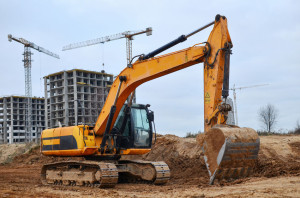Taking a closer look at concrete
 Engineering firms must be well acquainted with the materials we use on the job. And one of the more ubiquitous materials is concrete. It doesn’t matter where you are in Utah, from Salt Lake City to St. George, just about any and every building project involves concrete in some way, shape, or form. Concrete is a composite material composed of fine and coarse aggregate bonded together with a fluid cement that hardens over time. Concrete is the second-most-used substance in the world after water and is the most widely used building material.
Engineering firms must be well acquainted with the materials we use on the job. And one of the more ubiquitous materials is concrete. It doesn’t matter where you are in Utah, from Salt Lake City to St. George, just about any and every building project involves concrete in some way, shape, or form. Concrete is a composite material composed of fine and coarse aggregate bonded together with a fluid cement that hardens over time. Concrete is the second-most-used substance in the world after water and is the most widely used building material.
The concrete industry in the United States is so big that its combined value surpassed $116 billion in 2020. Globally, the concrete industry tops more than half-a-trillion dollars and is larger than the wood, steel, and aluminum sectors combined. What’s more, radical changes in modern architectural designs have significantly influenced the demand for precast concrete in columns, slabs, staircases, walls, floors, girders, etc., for industrial and commercial buildings. That’s why we wanted to take a moment in today’s blog to look at some of the advances in using concrete as one of our primary building materials.
What is low-noise concrete pavement?
Modern traffic construction puts a premium on controlling traffic noise. Damping excessive traffic noise has become an important criterion in the design and construction of transportation infrastructure. The noise pollution due to vehicular movements can be minimized through the construction of noise barriers or low-noise concrete pavement. Today, most construction and engineering firms utilize low-cost noise-canceling pavement as their primary method.
Several techniques have been developed to reduce noise pollution, but low-noise diamond grinding is the one that has captured the most attention. Low-noise concrete pavements are roads with a low-noise surface. The low-noise surface is achieved by including readily available diamond grinding technologies within heavy traffic road design. Not only do heavy traffic conditions on major roads need a strong and durable surface, but home and business owners are thankful when construction companies use low-noise pavement in their neighborhoods.
Even better, low-noise concrete can be applied quickly, effectively, and at a much lower cost than other concrete applications. Low-noise diamond grinding textures can be applied efficiently and quickly to concrete road surfaces without impairing other features like guard rails, noise barriers, or curbs. Low-noise concrete laying techniques are incredibly effective. Diamond grinding textures reduce road noises by almost 50% compared to plain concrete pavement. Grinding textures facilitate smoother rides and increase road safety.
How Does Curing Impact the Properties of Concrete?
Civil engineers will be very familiar with concrete internal curing. But what is it exactly and why is it needed? Internal curing is a technique that extends the hydration of cement without increasing the initial water-cementitious material ratio. This is important to ensure the concrete retains its internal strength.
Internal curing involves employing water stored in the saturated lightweight aggregate or superabsorbent polymer to cure concrete and help further with the hydration of cement. The lightweight aggregate is saturated before batching to absorb water in its pores, and the superabsorbent polymer absorbs a high quantity of water and releases it once the polymer contacts ionic materials.
But why is internal curing important? In short, it makes the concrete better. Internal curing improves various aspects of concrete. These aspects include the reduction of chloride penetration, early-age cracking, curling, durability, and material lifespan. Reducing concrete cracking is one of the primary benefits of internal curing. It may be argued that several factors contribute to cracking in concrete, but it is worth mentioning that the major factors are volume changes and restraints. So, controlling volume changes by minimizing autogenous shrinkage leads to a considerable reduction in potential cracking.
How do Admixtures Change Pumpable Concrete?
Any admixture that improves the workability of concrete is advantageous for enhancing the pumpability of concrete. Various chemical admixtures like air-entraining admixture, high-range water-reducing admixture, and finely divided admixture have been utilized to improve concrete pumpability.
The choice of the type of chemical admixture and its utilization in concrete depends on the mixture’s characteristics. Using air-entraining agents improves concrete cohesiveness and reduces segregation and bleeding. Mineral admixtures reduce the rate and amount of bleeding in concrete and improve its pumpability.
It’s essential to ensure a durable material is used when constructing houses and buildings so that they can survive environmental conditions and last the test of time. Concrete is widely considered to be the most popular building material as it provides a variety of benefits, including durability, sustainability, low cost and energy efficiency.
In the end, concrete is one of the most cost-efficient building materials and its price remains steady even when other material costs change. Costs do vary depending on the grade, finish, surface preparation cost and tools required so it’s important to bear this in mind. These are all factors we pay close attention to here at McNeil Engineering. To learn more about the work our civil engineers do day-in and day-out with materials like concrete, click or tap here.









